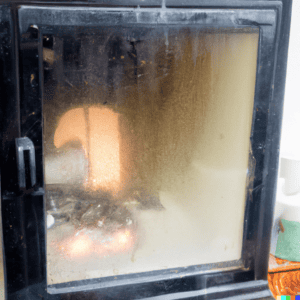Are you tired of the glass on your log burner turning black? A clean and clear glass window not only enhances the aesthetic appeal of your log burner but also allows you to enjoy the mesmerizing flames. In this article, we will provide you with effective tips and techniques to prevent the glass of your log burner from turning black.
By following these steps, you can maintain a clean and transparent glass surface, ensuring an optimal viewing experience.
Introduction
A log burner can create a cozy and warm atmosphere in your home. However, over time, you may notice that the glass window of your log burner starts to become covered in soot and turns black. This buildup not only obstructs the view of the flames but also reduces the efficiency of the log burner. Let’s explore the reasons behind blackened glass and discover effective ways to prevent it.

Understanding the Causes of Blackened Glass
The primary cause of blackened glass on a log burner is incomplete combustion. When the fire does not receive enough oxygen, it produces smoke and soot, which adhere to the glass surface. This incomplete combustion can be attributed to various factors, including poor quality fuel, improper seasoning of firewood, and inefficient burning conditions.
Choosing the Right Fuel
To prevent the glass of your log burner from turning black, it is crucial to choose the right type of fuel. Opt for well-seasoned hardwood, such as oak or birch, as it produces cleaner and more efficient fires. Avoid using wet or green wood as it contains higher moisture content, leading to smokier fires and increased soot buildup.
Properly Seasoning Firewood
Properly seasoned firewood plays a vital role in maintaining a clean log burner glass. When the firewood has a moisture content below 20%, it burns more efficiently, reducing the production of smoke and soot. Allow firewood to season for at least six months in a well-ventilated area before using it in your log burner. Investing in a moisture meter can help you determine the moisture content of the wood accurately.
Adjusting Airflow and Burning Conditions
Achieving the right airflow and burning conditions is crucial for preventing blackened glass. Ensure that the air vents on your log burner are fully open during the ignition phase to allow sufficient oxygen for complete combustion. Once the fire is established, gradually adjust the airflow to maintain a steady burn. Avoid closing the vents too much as it can lead to incomplete combustion and increased soot production.
Regular Maintenance and Cleaning
Regular maintenance and cleaning of your log burner are essential for preventing the glass from going black. Here’s a step-by-step process to clean the glass:
- Ensure the log burner is cool and has no live embers.
- Mix a solution of warm water and mild detergent.
- Dip a soft cloth into the soapy water and gently scrub the glass surface.
- Rinse the cloth and wipe away any soap residue.
- Use a dry cloth to wipe the glass until it is clean and streak-free.
Performing this cleaning routine every few weeks will help keep your log burner glass looking crystal clear.
Additional Tips and Tricks
- Avoid overloading your log burner with excessive wood, as it can restrict airflow and result in incomplete combustion.
- Use a fireguard or mesh screen to trap any escaping embers, reducing the chances of soot buildup on the glass.
- Consider using specialized glass cleaning products designed for log burners, as they can effectively remove stubborn soot and stains.
- Keep the area around your log burner clean and free from dust or debris, as these particles can contribute to soot formation.
Conclusion
Maintaining a clean and clear glass window on your log burner is essential for an enjoyable and efficient fire experience. By choosing the right fuel, properly seasoning firewood, adjusting airflow and burning conditions, and regularly cleaning the glass, you can prevent it from turning black. Remember to follow the recommended cleaning routine and incorporate the additional tips provided to keep your log burner glass looking its best.
FAQs
Q1: Can I use softwood in my log burner?
A1: It is generally recommended to avoid softwood, such as pine or spruce, as it tends to contain higher levels of resin and moisture, resulting in more soot and creosote buildup.
Q2: How often should I clean the glass of my log burner?
A2: It is advisable to clean the glass every few weeks or whenever you notice a significant buildup of soot. Regular cleaning helps maintain optimal visibility and prevents stubborn stains.
Q3: Can I use oven cleaner to clean the glass of my log burner?
A3: It is not recommended to use oven cleaner or any abrasive chemicals on the glass of your log burner, as it may damage the surface. Stick to mild soapy water or specialized log burner glass cleaning products.
Q4: Why is my log burner producing excessive smoke?
A4: Excessive smoke can be a result of improper burning conditions, wet or green wood, or a clogged flue. Ensure proper airflow, use well-seasoned firewood, and regularly inspect and clean the flue to prevent smoke issues.
Q5: Can I prevent soot buildup by burning hotter fires?
A5: While burning hotter fires can help reduce soot buildup to some extent, it is essential to maintain the right balance. Extremely high temperatures may damage the log burner or cause excessive wear and tear.









